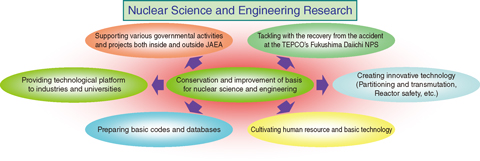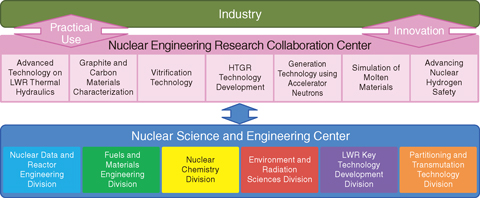
Fig.4-1 Roles of nuclear science and engineering research

Fig.4-2 Nuclear Engineering Research Collaboration Center
Nuclear science and engineering research aims to promote various activities, as shown in Fig.4-1. These include recovery from the accident at the Fukushima Daiichi Nuclear Power Station (1F) of Tokyo Electric Power Company, Incorporated development of transmutation technologies for reducing the amount of long-lived radioactive waste, and Light Water Reactor (LWR) key technologies for reactor safety improvement. In the area of nuclear data and reactor engineering, for the new edition of the Japanese Evaluated Nuclear Data Library (JENDL), measurement of nuclear data and development of a methodology for nuclear reactor design are being studied using advanced theoretical, experimental, and simulation approaches (Topics 4-1 and 4-2). In the area of fuels and materials engineering, research on the nuclear fuels and materials used in reactors and fuel cycle facilities is being promoted (Topics 4-3, 4-4, and 4-5). In the area of nuclear chemistry, research is being promoted on basic data for reprocessing and detection of extremely small amounts of nuclear materials and on practical uses of the above technologies (Topics 4-6, 4-7, and 4-8). In the area of environmental and radiation science, studies of the behavior of radionuclides in the environment and the development of a database for radiation protection are being promoted (Topics 4-9, 4-10, and 4-11). Joint research with industry is also being promoted via the Nuclear Engineering Research Collaboration Center with fundamental technologies (Fig.4-2).
For the development of fundamental technologies for 1F recovery, we are studying estimation methods for doses from Cs radioisotopes considering people’s age, prediction of Cs dose distributions in houses and buildings, chemical behavior of emitted radionuclides, simulation of melting fuel behavior, the effects of introducing seawater on fuels and structural materials, estimation of the reactor bottom situation after melt-down, and other topics (Chapter 1, Topics 1-2, 1-10, 1-14, 1-15, 1-16, and 1-18).
Technologies for the partitioning of minor actinide (MA) nuclides (ex. Neptunium and Americium) and fission products from spent nuclear fuel and for MA transmutation using accelerator-driven subcritical systems (ADSs) are being studied.